A snatch block, also known as a pulley block, is an exceptionally versatile winching accessory. It can be used to change a winch line’s direction, or to increase pulling power using mechanical advantage. If you have a winch, you should have a snatch block.
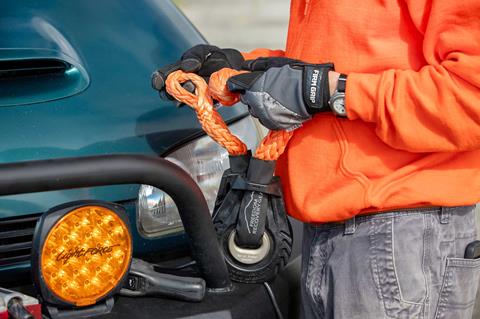
From traditional all-metal swing-side versions to minimal models that look like metal rings, snatch blocks come in various shapes, capacities, quality levels, and prices.
One of the latest blocks on the market is the Thompson Pulley Block from Canadian company, Freedom Recovery Gear. It takes ideas from traditional snatch blocks and aluminum rings to create a new approach to the pulley block.

Who is Freedom Recovery Gear?
Freedom Recovery Gear is based in Pritchard, British Columbia Canada, not far from Kamloops. It was founded in 2019 by off-road veteran and trainer, Richard Sheridan.
After 30 years of 4WD experience and watching people put their life on the line using poor recovery equipment, he knew he could do something. He had a vision of producing honestly rated recovery products for recreational off-roading, and hence Freedom Recovery Gear was launched.
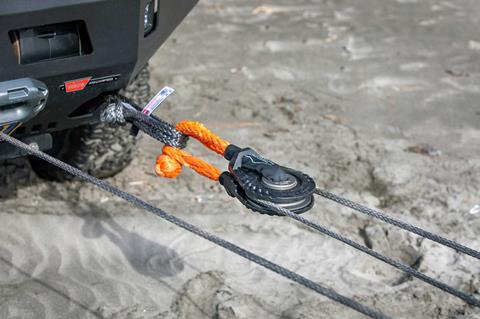
The Thompson Block’s Construction
The Thompson Pulley Block (named for the nearby Thompson River) is made from a variety of materials. The side plates are ultra-high-strength fiber-reinforced composite.
The wheel (or sheave) is constructed from hard-anodized billet 6061 aluminum and rides on a self-lubricating Aluma-bronze bushing with graphite inserts. A Freedom Recovery Gear ½” Tuff-Xtreme Trail Soft Shackle with a 65,500 lb. minimum breaking strength (MBS) and 13,100 lb. working load limit (WLL) runs through the block’s center. This shackle is also used for rigging the block.

How This Block Differs from the Others
Traditional swing-side snatch blocks have two plates, a wheel, and a hole for a rigging shackle connecting both plates. Metal recovery rings have the ring itself which rides on a soft shackle in the middle (also used for anchoring).
The Thompson Pulley Block is a hybrid of the two. It has swing sides and a bushing like a traditional block, and a soft shackle that runs through the middle like a ring which is used for anchoring.
The big difference? The Thompson Pulley Block’s wheel doesn’t ride directly on a soft shackle like a recovery ring. Instead, there’s a center section in the wheel which remains stationary and rides on the bushing. Therefore, there’s no friction imparted on the soft shackle, extending the shackle’s service life.
The block is held together with a 305 stainless steel spiral locking ring. The soft shackle can be removed if it needs replacing. The whole works weighs 3 lbs. and is serviceable.
Freedom Recovery Gear independently tests its products, and they meet a variety of standards. The Thompson Block is for use with synthetic rope only in diameters up to ½”.

Using the Thompson Block
The first thing I noticed about the block was its minimal weight. It looks heavy, but it’s not. It’s the only snatch block I’ve used that wasn’t mostly metal. It’s lighter than most snatch blocks but doesn’t impart friction on the soft shackle like recovery rings.
While I don’t doubt its durability during winching, I wonder if the composite sides are more prone to damage from being thrown around in a truck bed compared to metal. I’d be more careful with this block than a traditional metal one. [Update: The manufacturer just sent me a video of them hitting it with a 3 lb. hammer reassuring me the block is plenty strong!]
To test the block, I simply swung open the sides and put my winch’s 3/8” synthetic rope into the wheel’s groove. I didn’t need to undo the soft shackle (as shown in the photo), as the sides open wide enough with the shackle in place.
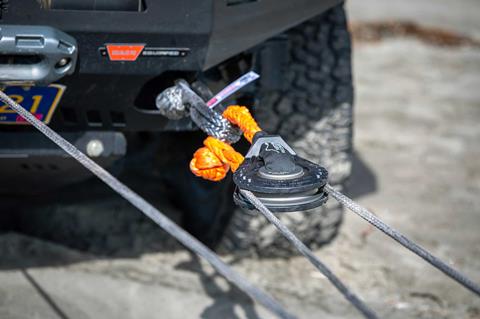
Due to the block’s tight tolerances, I had to gently guide my winch’s line onto the wheel’s groove more than a traditional block or ring. I closed the pulley sides—the rope definitely wasn’t going to fall out like it can on many recovery rings.
The included ½” soft shackle was too big to pass through my bumper’s recovery point opening, so I used a smaller 3/8” soft shackle, then anchored the block’s shackle to it. Once rigged up, the block worked smoothly and without incident. When done using it, simply slide the sides apart, and remove your winch rope.
The Thompson Pulley Block feels well-made and thoughtfully designed. Its lightweight is appreciated; the overall size (without shackle) is somewhat bulky at about 7” L x 2.5” W x 5.5” H”. The 13,100 lb. WLL allows it to be used with a variety of winch capacities, too.
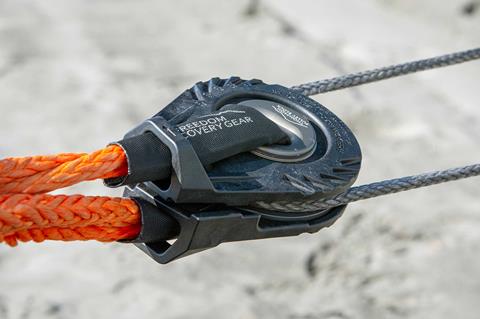
New, Different, and Very Good
The Thompson Pulley Block was designed in Canada as well as the USA and is manufactured in Canada. It has a one-year warranty against manufacturer defects. The cost? $220 USD.
Its unique blend of lightweight construction, tested and rated capacities, and North American manufacturing make it a unique bit of kit—perhaps one of the neatest takes on snatch blocks on the market. So, if you’re snatch block shopping and want a high-end pulley, the Thompson Pulley Block is definitely worth a look.
Access More Great Stories!
For more informative articles like this, consider subscribing to OVR Magazine in print or digital versions here. You can also find the print edition of OVR at your local newsstand by using our Magazine Finder.














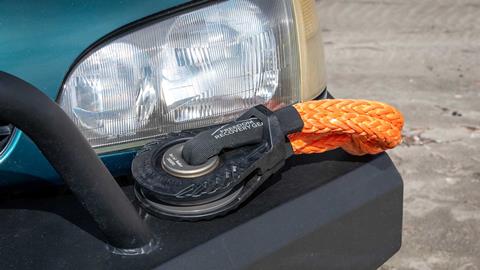






No comments yet